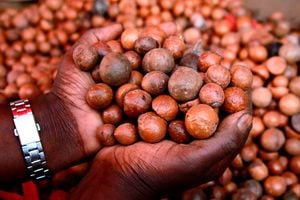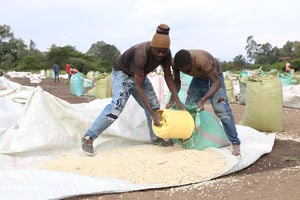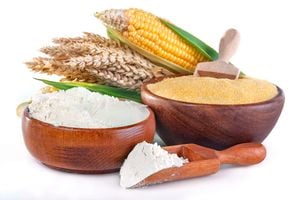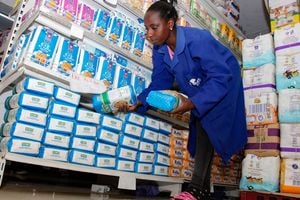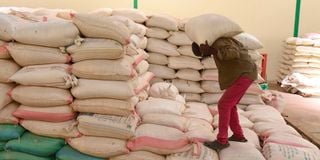
A worker offloads bags of maize at the Nakuru NCPB depot on January 31, 2024.
In 2023, a typical Kenyan consumed an average of 552.4 kilogrammes of food, data published by the Kenya National Bureau of Statistics (KNBS) shows.
This food's journey - from farm to fork - is a captivating story of what economists describe as the comparative advantage, with every county drawing from its strengths, plays a special role in feeding the 50 million Kenyans.
However, an analysis of fresh data from KNBS reveals an interesting pattern: Kenyans' food has increasingly come from a handful of counties, mostly those with sufficient rain and good soils.
Kenya's farming giants, analysis of the KNBS report shows are Meru, Nakuru, Nyandarua, Murang’a and Kiambu which recorded the highest performance in agricultural production in 2023, majorly due to their diverse crop production.
“These counties are high producers of tea, coffee, maize, vegetables, potatoes, and raw milk,” says KNBS.
Uasin Gishu, TransNzoia, Bungoma and Kakamega are the other counties that feed Kenya.
These counties are also major producers of wheat, Irish Potatoes, beans and sugarcane, which took up close to 70 per cent of the quantity of food a Kenyan consumed in the year under review.
The KNBS data shows that milk was the highest consumed food, with a typical Kenyan drinking 86.1 kilogrammes (86.1 litres).
Milk was followed by maize, used to make ugali, Kenya’s staple, with each Kenyan eating maize and maize and products of 63.3 kilograms.
At a per capita consumption of 48 kilograms, bananas are the third highest consumed food crop, followed by sugarcane (40.6 kilogrammes), wheat (39.3 kilogrammes), Irish potatoes (32.3 kilogrammes), Cassava (21.2 kilogrammes), and rice (21.1 kilogrammes).
A typical Kenyan consumed 15.1 kilogrammes of beans and 9.7 kilogrammes of meat in 2023.
So, which counties produce these foods?
Like in many other years since the founding of this country, in 2023 nearly every Kenyan had chai, milked tea for breakfast or even in the many occasions they attended.
Slightly over a third of the milk in the tea that Kenyans had for breakfast or when entertaining visitors in 2023 came from five counties.
From the biggest to the smallest producers these were Kiambu, Meru, Uasin Gishu, Nakuru and Murang’a respectively.
In some cases, the tea will be accompanied with boiled maize, or the chai itself can be replaced with gruel, or uji, both of which are prepared from maize.
However, maize has found itself on the dining tables of most Kenyans during lunch or supper time in the form of ugali.
The so-called grain basket counties are growers of maize, which for long has been synonymous with food security in Kenya, including Uasin Gishu, the leading producer of maize.
Uasin Gishu supplied to the national silos 476,538 tonnes of the cereal, Trans Nzoia (448,011 tonnes), Narok (314,403 tonnes), Bungoma (222,912 tonnes) and Nakuru (215,412 tonnes).
Kenyans also consumed a lot of bananas. Per capita, or per person, consumption of bananas in 2023 was 48 kilogrammes, according to the food balance sheet by KNBS.
The KNBS report does not give a breakdown of the production of bananas per county.
However, the 2019 census showed that Kakamega had the highest number of households growing fruit at 194,940, followed by Bungoma at 160,195 with Kisii coming third with 147,402.
Murang’a had the fourth highest number of households growing bananas at 144,925, Meru (118,020), and Nyeri (81,891).
Most Kenyans love their tea with sugar, which comes from sugarcane. In 2023, a Kenyan consumed 40.6 kilogrammes of sugarcane and sugarcane products.
Bungoma is the leading producer of sugar (92,409 tonnes), Kakamega (87,367), Kisumu (53,874), Busia (40,770) and Migori (31,938). Together these five counties had 65 per cent of the sugar produced in the country in 2023.
A typical Kenyan must have had bread or mandazi for breakfast. These foods are prepared from wheat.
In 2023, a Kenyan consumed on average 39.3 kilogrammes of wheat and wheat products, including cakes, croissants, burgers, hot dogs or pizzas.
Most of the wheat consumed in Kenya is imported from countries such as Russia and Ukraine.
However, there is some of the wheat is grown locally, with 94 per cent of it coming from counties such as Narok, Nakuru, Uasin Gishu, Meru and Laikipia.
Potatoes have found use in dishes such as Irio, bhajia, or fries. In the review period, a Kenyan consumed 32.3 kilograms of Irish potatoes.
The leading producers of Irish Potatoes are Nakuru, followed by Nyandarua, Elgeyo Marakwet, Meru and then Narok.
Kenyans also love boiled rice or pilau. On average, a Kenyan consumed 21.1 kilograms of rice in the review period.
Most of the rice that Kenyans ate was imported from countries such as Pakistan.
However, counties such as Kirinyaga with Mwea Irrigation Scheme have a headstart in the production of rice. Other counties producing rice include Kisumu which has such schemes Ahero, and Tana River which has the Bura Irrigation Scheme.
Ugali is often accompanied by meat stew. For those who love going out, they relish nyama choma.
In 2023, a typical Kenyan consumed 9.7 kilogrammes of beef. Most of the beef, the report from KNBS shows, came from Turkana, followed by Narok, West Pokot, Siaya and Kitui.
The produce that grows in the region, such as kale, spinach, cabbage, tomatoes, beans, potatoes, avocados, and other leafy greens, feature prominently in daily dishes.

